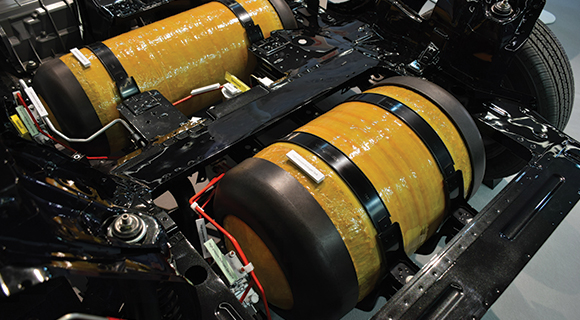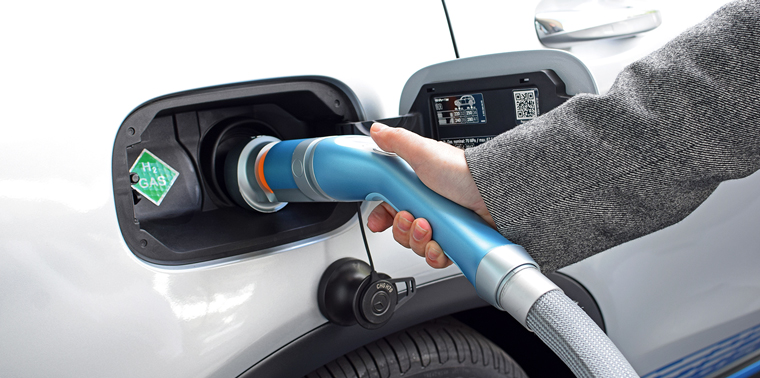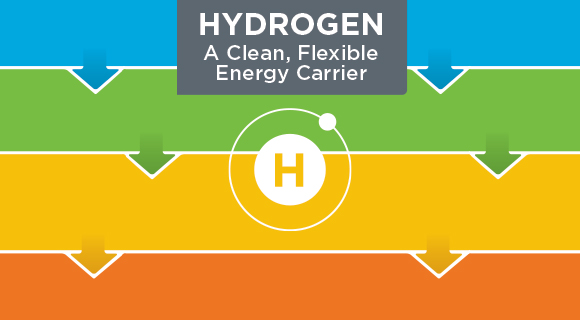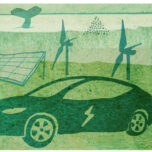November 6, 2018 — Jorgo Chatzimarkakis was refueling his hydrogen fuel-cell car at one of the 50-plus refueling stations scattered around Germany when a Tesla driver, who was recharging his own car, approached. 
The man was excited to see a hydrogen-powered car in action, and was brimming with questions. Chatzimarkakis, who is secretary general of Hydrogen Europe, was happy to answer them, and the two talked for several minutes.
But by then, the hydrogen car was fully refueled, while the Tesla driver still faced a long wait while his battery recharged.
“This is reality,” says Chatzimarkakis. “Nowadays the fueling stations are ready, the car is ready, I can plan my trip from Switzerland to Denmark and into Norway without any problems.”
The vision of a hydrogen-fueled world has had more near misses than Wile E. Coyote. In 1923, British geneticist J.B.S. Haldane imagined a network of hydrogen-generating windmills powering Britain, but nothing came of it. In 1970, South African-born electrochemist John Bockris first used the term “hydrogen economy” in a speech, and later published a book describing what a solar-hydrogen-powered world might look like. But again, nothing changed. In 2002, American economic and social theorist Jeremy Rifkin argued that hydrogen could take over from oil and that the future of energy lay in hydrogen-powered fuel cells.
But the industry was not ready, says Chatzimarkakis. “It was really very valid, what Jeremy Rifkin said, but politicians and journalists, they always want to see the proof,” he says. “And at that time it was really far away from being realized because the research was not advanced enough.”
Hydrogen Comes of Age
Perhaps, finally, hydrogen’s moment has arrived.
Japan is planning to use the 2020 Tokyo Olympic Games to showcase its vision for a hydrogen society and has invested US$348 million in establishing hydrogen refueling stations and other infrastructure. Germany has launched the world’s first hydrogen-powered trains to complement a growing number of hydrogen refueling stations across the country. Switzerland is purchasing 1,000 hydrogen-powered trucks, Norway has had hydrogen refueling stations since 2006, and South Korea is investing US$2.33 billion over the next five years to create hydrogen refueling stations, fuel-cell vehicle plants, fuel-cell buses and hydrogen storage systems. And Australia has seen both its national science agency CSIRO and chief scientist Alan Finkel separately report their visions for a hydrogen-powered nation and export industry.

The Coradia iLint began providing hydrogen-fueled mass transit in Germany in 2018. Photo courtesy of Alstom | R Frampe
At the heart of the hydrogen economy is the use of electricity from renewable sources such as solar, wind and hydropower to split water into oxygen and hydrogen — a process called electrolysis. That “green hydrogen” can then be used in fuel cells to generate electricity, and the fuel cells can be used individually to drive vehicles or in stacks to support or even power a grid. Best of all, the exhaust generated by hydrogen fuel cells is water, which one day might be recaptured and recycled for electrolysis again.
Economics and Climate
So what has changed to finally bring hydrogen to the forefront of global energy plans? Jenny Hayward, senior research scientist at CSIRO and co-author of its 2018 National Hydrogen Roadmap, says more favorable economics have played a significant part.
“You’ve got production coming down in cost, but also you’ve got utilization coming down in cost,” Hayward says. Not only has the price of electricity from solar photovoltaic and wind dramatically decreased, but electrolyzer technologies have also become much cheaper, larger-scale and more efficient. At the same time, hydrogen fuel cells are also improving both in efficiency and cost, she says.
Another major driver is the increasing urgency for substantial greenhouse gas emissions reductions, says John Andrews, a sustainable energy expert and professor at RMIT University in Melbourne, Australia.
“It’s so important to keep its introduction tied to being part of the solution of tackling climate change,” Andrews says. “It isn’t just a question of getting an alternative fuel; it’s a question of getting a zero-emissions fuel and energy system.”
Advancing the adaptation of hydrogen as a fuel hasn’t been easy. Despite the century-old quest for a hydrogen economy, there have been some significant technological challenges to overcome to get to this point — and it’s still early days.
Solving the Storage Problem
A key issue in using hydrogen for transportation has been storage. It’s only recently become possible to compress hydrogen into a container small enough and lightweight enough to fit in the back of a passenger vehicle, while still containing enough energy to fuel that car to at least 300 miles.
“It was always thought it would be very difficult to get a hydrogen storage that could beat the U.S. Department of Energy targets for use with hydrogen fuel-cell cars,” Andrews says. Then came the development of a high-pressure hydrogen tank made of advanced composites, which were able to meet and even exceed requirements.

Fuel storage has been a big challenge for hydrogen-fueled transportation. Recent improvements have extended the range of passenger vehicles to more than 300 miles per fill.
Photo © iStockphoto.com/Tramino
“I think that made people sit up and say yes, it is possible to have a form of storage that could be used to carry hydrogen on board a vehicle and give a range comparable with conventional cars and have a refill time — this is a critical advantage of hydrogen — of only a few minutes,” he says.
Hydrogen fuel-cell vehicles now match or even exceed the range of conventional gasoline or diesel vehicles; Toyota claims its Mirai gets around 312 miles from a tank of hydrogen. This makes them a far more attractive prospect for long distance travel than an electric battery-powered vehicle.
It also makes them a viable option for more hard-working vehicles, says Lisa Ruf, coordinator of Hydrogen Mobility Europe and principal consultant at Element Energy in the UK.
“In operations for trucks, for taxis, for emergency response services, you have to have the range and the refueling time that is similar to conventional vehicles,” she says, citing the case of the London Metropolitan Police, which this year acquired 11 hydrogen fuel-cell cars.
Feeding the Grid
Hydrogen is also being explored as a way to help maintain the stability of a renewable-fed energy grid, according to Morry Markowitz, president of the Fuel Cell and Hydrogen Energy Association in the U.S.
“Because the sun doesn’t shine all the time and the wind doesn’t blow, renewables have an intermittency problem, so you need to be able to find a way to effectively store the electrons being created,” he says. Excess electricity can be used to power electrolysis and generate hydrogen that can be used in fuel cell vehicles or stationary fuel cells, or stored for transportation.
This scenario is particularly appealing for remote areas, such as outback towns in Australia that otherwise depend on diesel-powered generators. Powering towns using a combination of renewables and hydrogen storage could soon become cost-effective, especially as the price of diesel rises, says Hayward.
Gas companies are also eyeing hydrogen as a potential alternative to natural gas, which could make use of the existing infrastructure.“That would be fantastic; then they’re not relying on trucks coming in with diesel, they just need their renewables,” she says. “They could have a system where they’ve got a fuel cell and they recover the water, so it’s a self-contained system.”
Gas companies are also eyeing hydrogen as a potential alternative to natural gas, which could make use of the existing infrastructure.
“Particularly if we’re going to go to high emissions reductions targets, they’re going to have all this gas infrastructure sitting there not being used,” Hayward says. “What’s interesting is in the gas distribution networks, if they’re made from PVC pipes you can have 100 percent hydrogen, although appliances and meters would have to be changed.”
The Hindenburg Effect
It’s impossible to talk about hydrogen without addressing the blimp in the room, what Markowitz calls the “Hindenburg effect.” The spectacular hydrogen-fueled inferno that was the Hindenburg airship disaster in New Jersey in 1937 still haunts the hydrogen industry, and the issue of hydrogen’s flammability and safety concerns are inevitably raised in discussions about the hydrogen economy.
But Markowitz says that hydrogen technology today is far advanced from the hydrogen technology of that era.
“Advanced materials such as carbon fiber tanks, sensors, computers and other things have improved so dramatically … safety for hydrogen should not even be an issue,” he says. “In the transportation sector and other areas, hydrogen vehicles meet or exceed anything that’s on the road today.”
There are also concerns that increased uptake of hydrogen could impact the ozone layer. A 2003 study suggested that if all fossil-fuel energy generation were replaced with hydrogen, leakage of the gas into the atmosphere could react with oxygen to form water vapor that could disrupt the ozone layer by a significant amount.
Another criticism often made of hydrogen is that a significant amount is still produced using fossil fuels. In the United States, most hydrogen is produced via a process called natural gas reforming, in which natural gas is reacted with high-temperature steam to produce hydrogen, carbon monoxide and a small amount of carbon dioxide. It can also be made by gasifying brown coal, which also results in CO2 production.
“If you follow either of those routes to get hydrogen, there are some carbon dioxide emissions that come from those routes, so the only way you can make that zero emission is to couple that with carbon capture and storage,” says Andrews. “And that’s still a big question as to whether that can be viable, whether it’s going to be safe and we can keep that carbon dioxide for thousands of years under the ground and whether it can ever be economic.”
Measured Approach
There is a sense of urgency to discussions about hydrogen, reflecting the widespread acknowledgment that there is a need to decarbonize transport, Ruf says. She argues that while there is a range of solutions on the table, hydrogen is able to address issues that other technologies can’t do quite so easily or cost-effectively.
But while there is much excitement about the potential of hydrogen, Ruf also counsels for a measured approach.
“The problem we have I guess as a sector for supporting hydrogen fuel-cell technology is that we have to be wary of the hype and we have to be able to manage expectations,” she says. “It’s something that takes time and investment. It will not happen overnight, but in the long-term it’s a very good solution.” ![]()
Editor’s note: The author has done contract writing for CSIRO in the past, though not related to hydrogen fuel.
Related Posts
Ensia shares solutions-focused stories free of charge through our online magazine and partner media. That means audiences around the world have ready access to stories that can — and do — help them shape a better future. If you value our work, please show your support today.
Yes, I'll support Ensia!






How so? For the same price as a Mirai my Tesla Model 3 has a 310 mile range. And there is a nationwide Supercharger network unlike hydrogen which only has a handful of stations mostly in CA only.
In fact this year alone I've taken multiple trips that were 400-500 miles in my Model 3. For a 6 hour trip like this we usually stop every 2 - 2 1/2 hours anyway for breaks so stopping to charge for 15 minutes each time is enough.
And even better the rest of the year in which daily commuting and local driving is a majority of my driving, I simply charge at home and never have to waste my time to go out of my way to fuel up. You cant do this with hydrogen.
now offer equivalent density storage at 20 bar pressure versus 790 bar saving much energy to compress gas. Solid and liquid Hydrate hydrogen generator solutions have been recently introduced that are multiples higher density by weight and volume. The future of clean energy may be as simple as a laundry soap and water.
The Toyota Mirai is a "2nd gen" fuel cell. Much larger and inefficient.
Distribution and cost are the main obstacles right now. Until more fueling stations are laid out, the FCEV and BEV are competitors for those of us who have homes with garages. But, on the road, once you get more refueling stations, the FCEV is just like a normal car.
Importantly, there is also the issue of superior throttle characteristics of the EV: FCEV, BEV, serial hybrid.... the instant torque off the line and the lack of transmission, which makes for an extremely easy to drive platform at low and mid speeds. At high speeds, it feels "different" as well, specially with the quiet FCEV and BEV.
Maar door problemen met onze auto een heel vreemd probleem een deel rubber zat dubbel bij het koeling systeem en niemand had het door. Alle meters hadden echt niet door van een zo simpel probleem. Dus nadenken is nog steeds heel erg nodig
Hydrogen and the fashion now Amnonia wont solve anythings, and big money will be wasted for nothing. The error of the H2 economy is that it consideres the electricity coming from renewables as free and limitless.